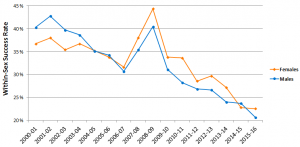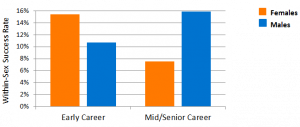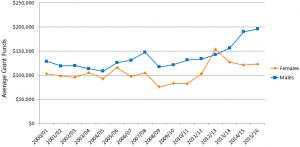
By Liisa Galea, Ph.D.
On August 15, 2017, CIHR released a report outlining gender differences in the amount of approved CIHR funding and in March, 2017 on gender inequities in success rates with Project, Open Operating and Foundation grants1. Overall, within-sex success rates across all CIHR grant programs did not show a strong bias, with women showing overall higher within-sex success rates from 2007 to 2016 than men, with the exception of 2014-15. Perhaps more concerning is that overall success rates have dropped from a high of 40% to less than 25% over those same years. However the story starts to change when examining the data by particular granting opportunities within CIHR.
All CIHR grant competitions between 2000/01 to 2015/16
The greatest diversity in terms of within-sex success rates favouring higher rates in men was in the Foundation Grant completions with 12-14% within-sex success rates for men but 8-10% in women over the 2014 to 2015 competition. Curiously, the within-sex success rates differed by career stage, with much higher within-sex success rates for men in the mid/senior career researchers compared to women but this same disparity was not seen in the early career researchers.
Foundation 2015/16 Competition
This finding seems to parallel the findings that fewer women awarded CRC and CERCs2 that the Canadian government is working to address3. CIHR is making concerted efforts to correct these biases and we applaud them for paying attention to this matter. They have new CIHR Gender Equity Framework4.
However, equally concerning is that women, depending on career stage and funding competition, are not only less successful in their grant success but are receiving less money per grant, with the average disparity at $72,833.47 per year. The largest disparities in funding amounts between men and women researchers were seen in Clinical Research and Social, Cultural, Environmental and Population Health Research with an average of over $82 000 or $142,000, respectively, per year in 2015/16.
All CIHR grant competitions between 2000/01 to 2015/16
It’s worth understanding that unlike NIH and other granting agencies CIHR budget allocations are based on what the researcher has asked and budgeted for thus it is more than likely that women are asking for less money to fund their grants than men. We urge researchers to budget for and ask for the appropriate amount of money to fund their research. Researchers should also be aware that typically CIHR has been using across the board cuts of 25-30% to budgets.
It is important to applaud CIHR and their work to be more transparent in funding decisions and metrics. It matters as diverse researchers will examine different topics as so eloquently written about recently by Allison Sekuler5. Thus, it has been suggested that women’s health is more likely to be researched by women4 and these results from CIHR and NIH6 suggest that the field is underfunded.
We applaud the Canadian government, CIHR and the Honourable Kristy Duncan for highlighting and drawing attention to Equity, Diversity, and Inclusion Action Plan3. This can only help women’s health.
References
- http://www.cihr-irsc.gc.ca/e/50497.html
- http://www.chairs-chaires.gc.ca/media-medias/releases-communiques/2017/equity-equite-eng.aspx
- http://www.chairs-chaires.gc.ca/program-programme/equity-equite/action_plan-plan_action-eng.aspx
- http://www.cihr-irsc.gc.ca/e/50238.html
- https://www.theglobeandmail.com/opinion/because-its-almost-2018-inclusivity-enhances-our-excellence/article36941996/
- https://www.statnews.com/2016/07/29/women-in-science/


